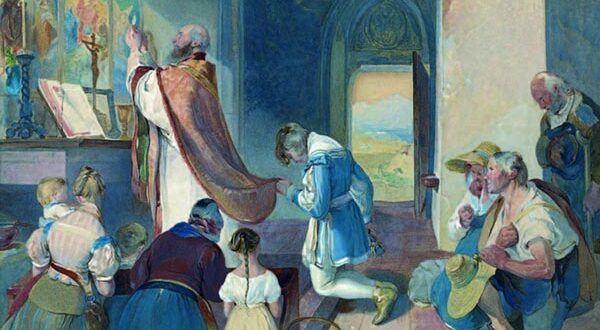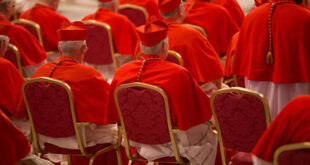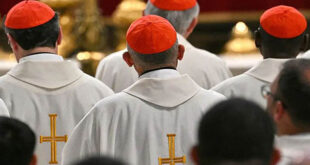In the Holy Mass, at the most sacred moment of the Eucharistic sacrifice, the priest pronounces the sublime words of consecration: “Hoc est enim Corpus Meum” (“This is My Body”). With these words, taken directly from Christ’s institution of the Eucharist, the miracle of transubstantiation occurs: the bread ceases to be bread, and the wine ceases to be wine, becoming truly, really, and substantially the Body and Blood of Christ.
This mystery has been the object of contemplation, adoration, and defense by the Church throughout the centuries. In this article, we will delve deeply into its meaning, its biblical foundation, its doctrinal development, and its significance for the life of every Christian.
I. Biblical Foundation: The Word That Gives Life
The doctrine of Christ’s Real Presence in the Eucharist is based on His own words at the Last Supper:
“Take and eat; this is my Body” (Mt 26:26).
“Take it; this is my Body” (Mk 14:22).
“This is my Body, which is given for you; do this in memory of me” (Lk 22:19).
This is not a metaphor or a symbol, but a literal affirmation of Our Lord. Jesus does not say, “this represents My Body,” but “this is My Body.” This teaching is already foreshadowed in the Bread of Life Discourse in Capernaum:
“I am the Living Bread that came down from heaven. Whoever eats this Bread will live forever, and the Bread that I will give is My Flesh for the life of the world” (Jn 6:51).
The Jews are scandalized by these words because they understand that Jesus is speaking literally. Instead of softening His teaching, Christ reaffirms it even more clearly:
“Truly, truly, I say to you: unless you eat the Flesh of the Son of Man and drink His Blood, you have no life in you” (Jn 6:53).
Many disciples, unable to accept this mystery, abandon Him (Jn 6:66). However, Jesus does not stop them by explaining that He was speaking figuratively. Instead, He allows them to leave, making it clear that His words must be taken seriously.
II. Transubstantiation: The Transformation of Bread and Wine
The Church teaches that at the consecration, a profound change occurs in the Eucharistic species. This transformation was explained by St. Thomas Aquinas using the term “transubstantiation,” later defined at the Council of Trent (1545–1563):
“By the consecration of the bread and wine, a change takes place in which the entire substance of the bread becomes the substance of the Body of Christ our Lord, and the entire substance of the wine becomes the substance of His Blood. This change is appropriately and properly called transubstantiation” (Denzinger 1642).
Although the accidents (color, taste, appearance, texture) of the bread and wine remain, their substance is completely changed. They are no longer bread and wine; they are Christ Himself, living and glorified.
This is a unique miracle, as in natural changes, substances change along with their accidents. However, in the Eucharist, the substance changes while the accidents remain. This is a miracle that surpasses human reason but is accepted by faith with humility.
III. The Worship Due to Christ in the Eucharist
From the earliest centuries, the Church has recognized and adored the Real Presence of Christ in the Eucharist. St. Justin Martyr (†165) testifies that Christians of his time already believed in the conversion of the bread and wine into the Body and Blood of Christ.
The Council of Trent reaffirmed this teaching, condemning Protestant doctrines that denied the Real Presence. The Church declares with clarity:
“Christ is entirely present under each species and under each of their parts” (Denzinger 1653).
For this reason, the Church recommends Eucharistic adoration, the exposition of the Blessed Sacrament, and frequent Holy Communion. Saints like St. Alphonsus Liguori, St. Teresa of Jesus, and St. John Vianney emphasized the importance of Eucharistic adoration as a source of grace and spiritual transformation.
IV. The Eucharist and the Life of the Christian
1. The Eucharist as a Source of Life
St. Ignatius of Antioch called the Eucharist the “medicine of immortality,” because it unites us intimately with Christ and strengthens us to live in grace. St. John Paul II taught that “the Church lives by the Eucharist” (Ecclesia de Eucharistia).
2. The Need to Receive Holy Communion in a State of Grace
St. Paul warns in 1 Corinthians 11:27:
“Whoever eats the Bread or drinks the Cup of the Lord unworthily will be guilty of the Body and Blood of the Lord.”
This means that receiving Communion in mortal sin is a sacrilege. Therefore, the Church commands confession before receiving Communion for those in a state of grave sin.
3. The Fruits of Holy Communion
- Union with Christ: “Whoever eats Me will live because of Me” (Jn 6:57).
- Increase in sanctifying grace: strengthens us on the path to holiness.
- Forgiveness of venial sins and preservation from mortal sin.
- Unity with the Church: “Though we are many, we are one bread and one body” (1 Cor 10:17).
Conclusion: Faith in the Words of Christ
The words “Hoc est enim Corpus Meum” summarize the core of the Christian mystery: God has made Himself food for our salvation. Before this miracle, only humble faith and adoring reverence are appropriate.
May the Blessed Virgin Mary, the Eucharistic Woman, help us receive Her Son with love and reverence in every Communion, and may our lives reflect the transformation that only the Eucharist can work in the soul.
Let us adore the Blessed Sacrament with faith, love, and gratitude!






